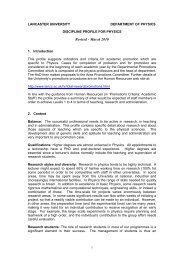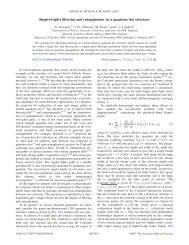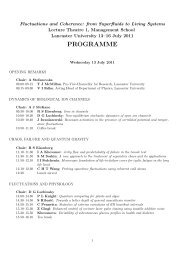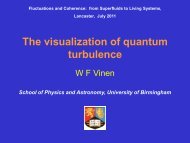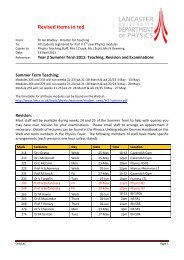SBIG Self Guided Spectrograph (SGS) Operating ... - Sbig.com
SBIG Self Guided Spectrograph (SGS) Operating ... - Sbig.com
SBIG Self Guided Spectrograph (SGS) Operating ... - Sbig.com
- No tags were found...
Create successful ePaper yourself
Turn your PDF publications into a flip-book with our unique Google optimized e-Paper software.
Z = velocity/C, where C = 300000 km per second (for non-relativistic speeds)Objects moving away from you are shifted to the red. Our position in the spiral arm ofthe Milky Way results in a 215 km per second imposed on objects outside the galaxy,depending on their direction relative to the galactic equator (which is quite tilted relativeto the celestial equator). Velocities of remote galaxies are sometimes given relative tothe center of the Milky Way, so use reference publications carefully.When you are <strong>com</strong>fortable with the unit, you can attempt measuring galactic redshifts. Galaxies are hard since they are faint, extended, and mostly have a continuumspectra. Capture some spectra in low resolution mode with the wide slit and longexposures, such as 10 to 20 minutes, with multiple exposures. One usually does not needa calibration lamp on during the exposure since light pollution and natural airglow lineswill be recorded, but at a low level. It is much easier to measure red shifts for Seyfertgalaxies, which have an excess of H-alpha and show emission lines, than other galaxies.Even the knots of H-alpha in galactic arms may be easier than the core. Take aconventional CCD image with an H-alpha filter or red filter to reveal the H-alpha regions,which can then be positioned on the slit. They are difficult to see on the tracking CCD,and may require that you estimate where they are from the galaxy core and nearby stars,and put the desired part of the sky on the slit. On trick is to rotate the spectrograph sothat the slit runs through both the core and the H-alpha region, so you can improve yourchances of hitting it. While rotating the spectrograph-camera <strong>com</strong>bination is not thateasy, neither are one hour exposures. If you are capturing spectra of galaxies with littleH-alpha, look for the sodium doublet absorption feature to detect red shifts, and <strong>com</strong>pareit with spectra of M0 stars. The older red stars that <strong>com</strong>prise most galaxy cores show thesodium feature. Do not bother with high resolution since the random motion of the starswithin the galaxy blur the spectral features to several angstroms wide anyway.M82 is a bright galaxy with a small red shift but copious H-alpha and very highvelocities in its core. It is a good initial target with the narrow slit to see thedisplacements of the spectral line across the core.Quasars can be detected. Their spectra approximates a galaxy with superimposedemission lines. Fortunately their energy in spectral lines is great so, while they are faint,their red shift is more easily measured than galaxies.8.0 Parting CommentsThe field of amateur spectroscopy is quite new. Only now is equipment <strong>com</strong>merciallyavailable to make measurements of stellar spectra, radial velocity, and emission nebula.As a result there is a shortage of publications that help the amateur interpret the spectraobtained, and plan interesting observing programs. The popular magazines are beginningto fill this shortage, working in conjunction with the advanced amateurs using ourequipment. As the discipline matures we will strive to build the capability into ourequipment that is needed, for presently we too have limited knowledge of what theamateur requires. Good luck!13






